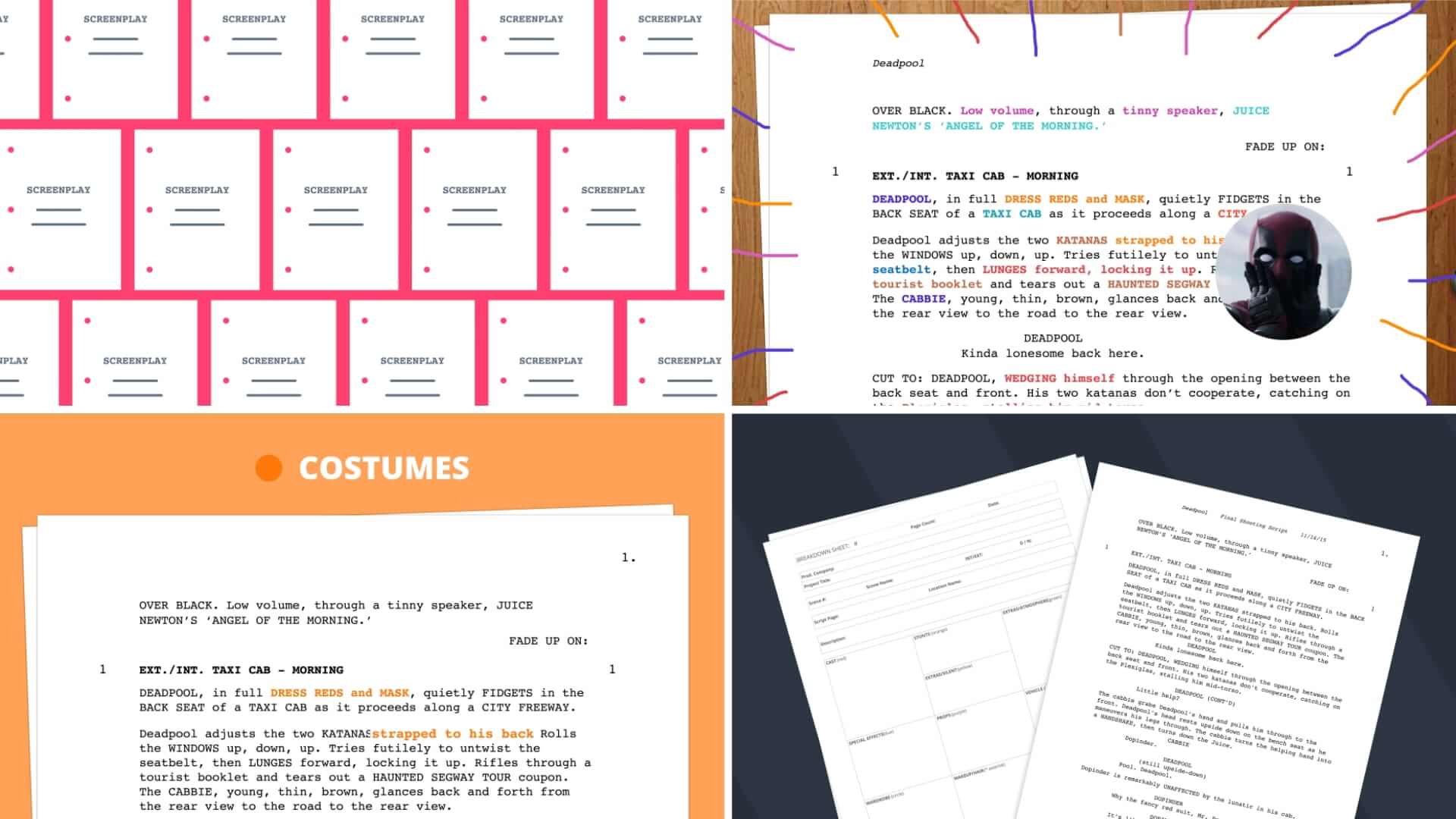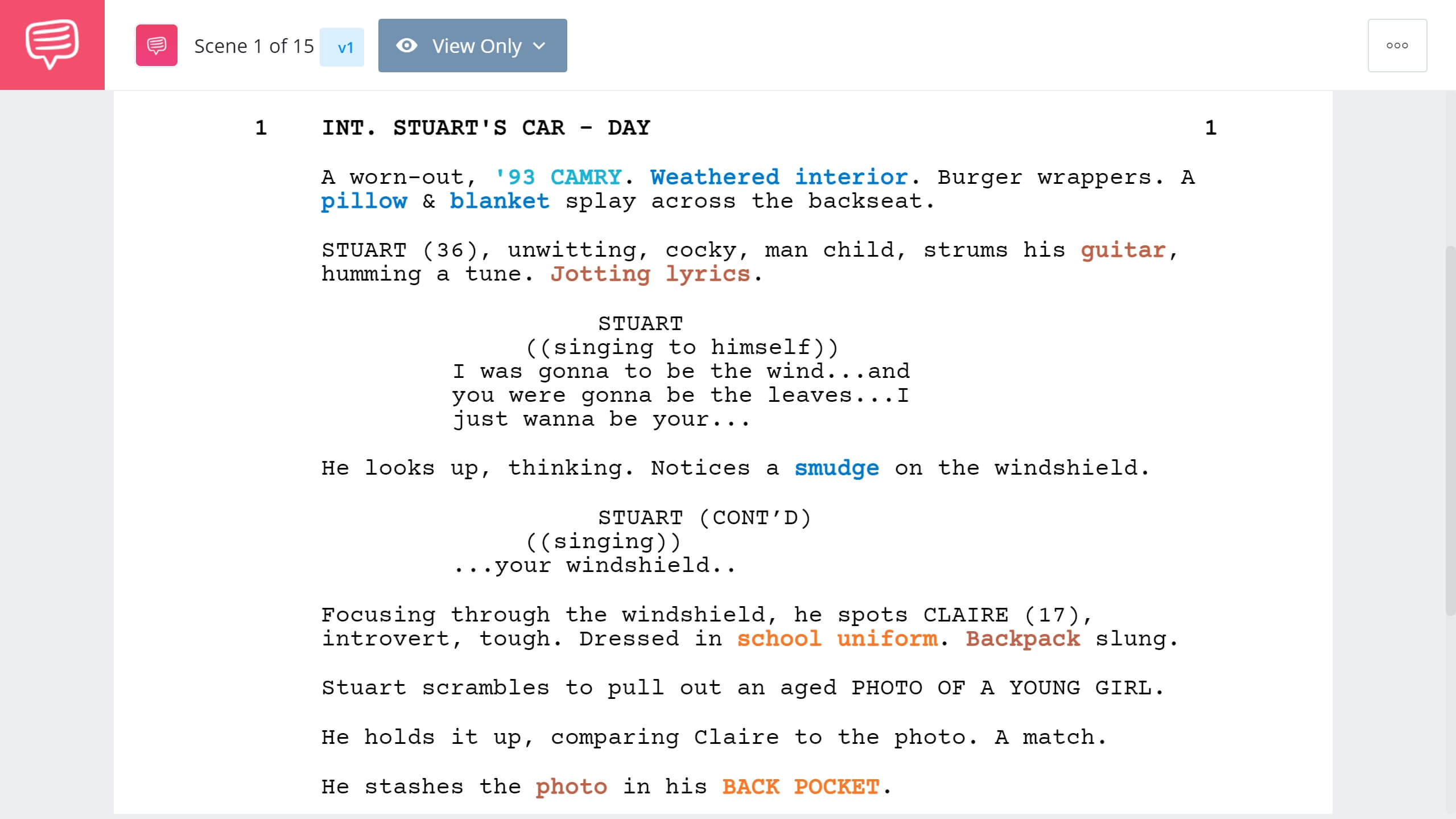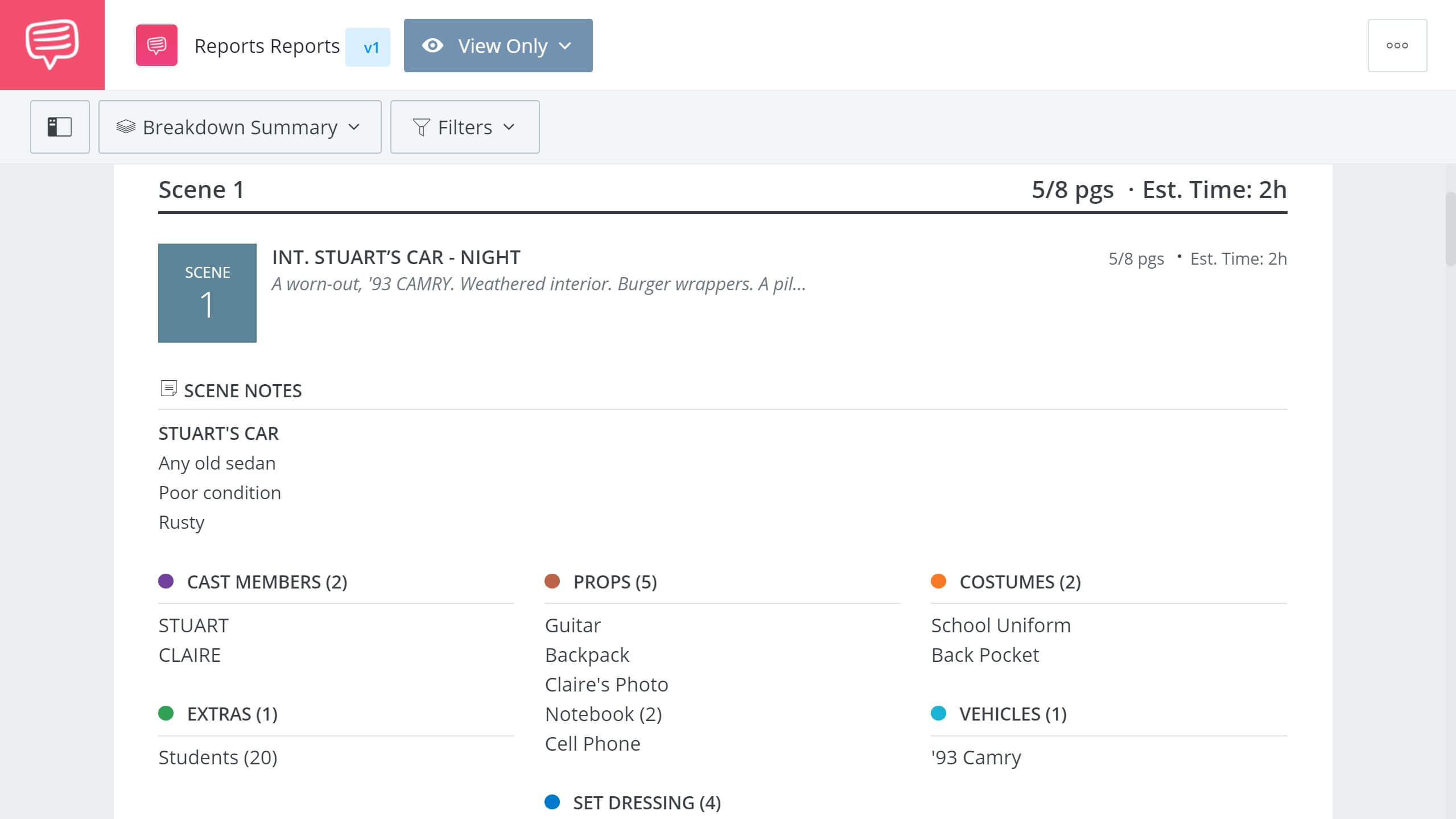Whether you are a producer, 1st AD, or script supervisor, breaking down a script is an incredibly daunting and tedious task. Overtime, the process of breaking down a script by color has become the only organized and efficient way of tackling the task. In this article, we’ll take a look at how to breakdown a script by script breakdown colors both by hand and using the StudioBinder script breakdown app.
script breakdown colors tutorial
What are Script Breakdown Colors?
Before we get into the Studiobinder app, let’s do a quick rundown of what script breakdown colors are. In previous posts, we’ve looked at how to mark up a script for production scheduling, but this kind of breakdown is a bit different.
SCRIPT BREAKDOWN COLORS DEFINITION
What are script breakdown colors?
Script breakdown colors are a way to break down scenes into their individual elements by highlighting them with their own color. The specific colors can vary.
Some breakdown colors:
- Purple – Props
- Red – Actor with a speaking part
- Yellow – Extra without lines
- Blue – Special effects
Sound complicated? Don’t worry– StudioBinder is here to help.

Script Breakdown Categories
script breakdown colors tutorial
Upload the script
In today’s digital age, there are more technological tools for film production than ever before. This boasts true for the script breakdown process.
While you may be tempted to break down your script by hand, you may find it time consuming and tedious. Using a software such as StudioBinder’s script breakdown app is efficient, painless, and free to try.
To begin, simply upload your script into the software. Learn how to upload your script and start breaking it down by checking out the video below.
How to breakdown a script: Getting Started • Subscribe on YouTube
Still feeling shaky? Check out our breakdown sheet template for more. Whether you choose to use the software or breakdown your script by hand, these next few steps will help you better understand how to break down your script by color.
script breakdown colors tutorial
Read and reread the script
Before making any mark on the script, it’s important to read and reread the entire screenplay. This will allow you to have a solid understanding of the story and scenes before taking another pass on the script to break it down.
A single scene can have numerous amounts of production elements to mark. To avoid missing this it’s crucial to already have comprehensive knowledge of the screenplay. Just take a look at this example breakdown of a scene from the Deadpool script.
Note how many production elements are found in a single scene.
How to breakdown a script (ft. Deadpool) • Subscribe on YouTube
To recap, read and reread the script so that you can focus specifically on production elements rather than story details and scenes when you start breaking down the script.
Related Posts
how to divide a script in script breakdown
Divide script into 1/8ths
If you decide to break down your script by hand, begin by dividing every page of the script into perfect 1/8ths or 1 inch parts. Why? Every page of a script is roughly equal to one minute of screen time. Dividing your pages into 1/8th will give you a more precise estimate as to the screen time duration of each scene.

How to breakdown a script
If you’re using the StudioBinder script breakdown app, the software will automatically divide the page into eighths and inform you on the script's length. Once you’ve divided every page into precise 1/8ths, it’s time to start marking up and tagging production elements.
how to mark production elements in script breakdown
Mark production elements
If you’re breaking down you script by hand, buy a wide variety of script breakdown colors. Next, assign each element specific script breakdown colors. The script elements will vary depending on your script, but begin with the most fundamental elements such as cast members, extras, props, set dressing, costumes, makeup, vehicles, stunts, and special effects.
The team over at Film Riot has a great tip which involves using flashcards to organize production elements and script breakdown colors as you break down your script by hand. Check out how they do it in the video below.
How to breakdown a script 101
As you go through the script, begin marking every production element. Make sure you go through the script a few times to ensure you did not miss anything. This sounds tedious because it is. For props, take a look out how to write out a prop breakdown.
To make the process less tedious and more efficient, StudioBinder’s script breakdown app allows you to tag elements by script breakdown colors quickly and organize them automatically once tagged. Check out the video below to learn how to easily tag elements in the app.
Script breakdown example: Tagging Elements • Subscribe on YouTube
As you can see, we have predetermined script breakdown colors in our breakdown app. You can also create a new custom category in which you can choose the script breakdown colors for a specific element. Repeat this process for every page and scene of the script.
Once you’ve given your script a couple passes and feel like every production element is tagged, every page of your script should look a bit like this sample breakdown below.
Script breakdown example
After all the tagging and highlighting, you’ll need to organize the production elements within breakdown reports. This is really where using the StudioBinder app comes in handy and saves a ton of time.
Related Posts
Breakdown of a script
Create breakdown reports
Breakdown reports essentially take the highlighted elements in the script and organize them into appropriate categories such as “Cast Members,” “Props,” and “Set Dressing.” If you are doing this by hand, that does mean you will have to create these breakdown reports by hand by manually writing each element into a breakdown template.
However, if you’re using the StudioBinder breakdown app, creating breakdown reports is as easy as a few clicks. Check out the video below for a tutorial on how to generate breakdown reports in StudioBinder once you’ve tagged all your production elements by script breakdown colors.
How to Generate Breakdown Reports: Script breakdown example • Subscribe on YouTube
Once generated, your breakdown reports will be available to print or email to the various heads of your departments. The end result will look similar to the sample breakdown reports below.
Script breakdown example
Breaking down a script by script breakdown colors is without a doubt the most organized and efficient way to break down the various production elements of a screenplay. That being said, breaking a script down by hand with colors is still an incredibly tedious task. For more on breaking down a script, be sure to check out our complete guide to mastering the script breakdown.
Utilizing StudioBinder’s script breakdown app not only saves time, but will reduce the chances of overlooking important production elements and details.
Related Posts
UP NEXT
How to make a shooting schedule
If you’re tackling a script's breakdown, odds are you’re also involved in the script’s shooting scheduling. Learn how to make an organized shooting schedule using stripboards in our next article.
Up Next: Make a Shooting Schedule →
Easily create script breakdown sheets online.
Import scripts. Tag elements like props, wardrobe, and cast. Create breakdown summaries and DOOD reports in a snap.


